Rinpoche's Lineage

Samantabhadra, the primordial Buddha, is pure omniscience, the essence of the enlightened mind of all the Buddhas. He is embracing Samantabhadri, the female primordial Buddha. Their union represents the fusion of wisdom and compassion, the ultimate indivisibility of samsara and nirvana and the potential for Buddhahood inherent in all sentient beings. Samanta means, “universally extending.” Bhadra means “great virtue.” Samantabhadra means to extend such great compassion that every sentient being is benefited and to practice so extensively and profoundly that all virtue is perfected.
Vajrasattva is the manifestation of the purity of body, speech, and mind of all the Buddhas. As a meditational deity Vajrasattva is visualized as an expression of mind’s pure essence. In this way negativities and obscurations are cleansed allowing Buddha nature to manifest. As a Bodhisattva, Vajrasattva saw that all beings suffered because of their negative karma and made a vow to free all beings of this karma.
The first human lineage-holder of the Dzogchen teaching was the Nirmanakaya Garab Dorje, an emanation of the Buddha Vajrasattva. He was born a son of a royal family in Oddiyana. He showed many special signs that he was not an ordinary child. At age 7 he entered into a philosophical debate with 500 scholars and defeated all of them, without ever having studied himself. Afterwards he meditated on a mountaintop until his 32nd birthday. He received empowerments, instructions and entrustment of the Dzogchen tantras in an instant from Vajrasattva and attained the stage of “no more learning.” With the help of dakinis he spent three years transcribing the teachings he had received. He meditated and taught for the rest of his life in Sitavana, a famous charnel ground northeast of Bodhgaya. When he died at the source of the Danatika, river his body dissolved into immaculate space amid masses of rainbow light.
In 626 B.C.E. our supreme Dharma teacher, Buddha Shakyamuni, was born in southern Nepal, which in ancient times was northern India. At the age of thirty-five, Shakyamuni attained Buddhahood in Bodhgaya, India, and began to teach the dharma in this world. For the next forty-seven years, the Buddha’s teachings flourished throughout the universe and as a result many sentient beings attained enlightenment. At the age of eighty-two, Buddha Shakyamuni passed into nirvana. Thereafter, the Buddha Shakyamuni manifested in two wisdom emanations.

Manjushrimitra was born into a Brahman family to the west of Bodhgaya in India and became a great scholar. In a vision Manjushri instructed him to travel to the Sitavana charnel ground in India if he wished to reach enlightenment during his lifetime. He met Garab Dorje there and studied the Dharma with him for 75 years. When Garab Dorje attained nirvana, Manjushrimitra beheld him in the sky in a mass of light. With the sound of a thunderclap a tiny golden casket descended from the light into the palm of his hand. Inside Manjushrimitra found the Three Words That Penetrate the Essence written on a leaf. Just by seeing it he attained realization equal to that of his teacher. He classified the 6,400,000 verses of the Dzogchen teachings into categories, recorded the oral transmissions he had received and concealed them in a boulder marked with a crossed dorje. He meditated for many more years at Sosadvipa, a charnel ground west of Bodhgaya, and transmitted the Dzogchen teachings to Shri Singha.
Shri Singha was born in China and was a great scholar of worldly sciences. In a vision, Avalokiteshvara instructed him to go to the Sosadvipa charnel ground in India where he would attain enlightenment. To prepare for his pilgrimage to India, Shri Singha studied different tantras for seven years on the sacred mountain of Wu T’ai Chan. He then took ordination and maintained monastic discipline for 30 years. Avalokiteshvara appeared to him again and repeated his advice. Before departing for India Shri Singha, he engaged in a practice that resulted in achievement of miraculous powers, allowing him to travel to Sosadvipa very quickly. He met Manjushrimitra there and studied and practiced with him for 25 years.
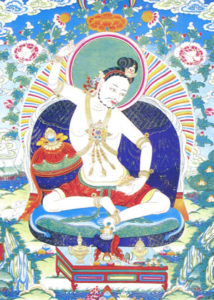
When Manjushrimitra achieved the rainbow body, Shri Singha received his master’s final testament, and meditating with those instructions he realized the essential meaning of Dzogchen. Shri Singha was also able to withdraw the texts Manjushrimitra had hidden in the rock near Bodhgaya. Upon his return to China, he hid the first three cycles of teaching near the Bodhi Tree Temple in China.
Following the instructions of a dakini, he concealed the Nyingtik (Heart Essence) cycle in a pillar in the Tashi Trigo Temple. After this Shri Singha lived in the Siljin charnel grounds, meditating and giving teachings. As he achieved the rainbow body, his final testament descended into the hands of his disciple, Jnanasutra.
Jnanasutra was born to a low caste family in Kamashila, eastern India. Jnanasutra became a scholar and traveled to Bodhgaya where he met Vimalamitra. Vajrasattva appeared to them both and instructed them to travel to the Bodhi Tree Temple in China to meet Shri Singha. Jnanasutra obeyed Vajrasattva’s advice only after his friend Vimalamitra returned from China with glorious news of his meeting with their master. When Jnanasutra arrived at the temple, a dakini instructed him to go to the Siljin charnel ground. He served his master for three years and then beseeched him for teachings.
He stayed with the master receiving teachings and empowerments for many years. During this time Shri Singha often behaved in mysterious ways, wandering in charnel grounds, transforming into various forms, mingling with the dakinis and facing frightening beings without the slightest fear. Eventually Shri Singha told Jnanasutra that the texts of the teachings would appear when the time was right. Seven days after his master left him to visit the King of the country of Li, Jnanamitra saw Shri Singha appear in the sky and knew that he had passed on. He received a casket containing the verses called the Seven Nails and instructions to extract the Nyingtik teachings from their hiding place at the Tashi Trigo Temple, and to meditate on them at the Bhasing charnel ground in India. Jnanasutra returned to India with the texts and lived in the Bhasing charnel ground teaching the Nyingtik to dakas and dakinis. He also transmitted the teachings to his friend and disciple, Vimalamitra, and entrusted to him the texts of the entire oral tradition. At the end of his life his mortal body dissolved into a body of light.
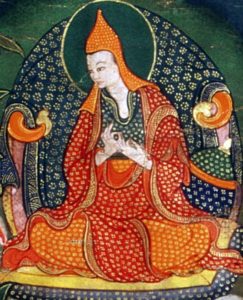
Vimalamitra was born in western India. While living in Bodhgaya, he met Jnanasutra. Vajrasattva appeared to them and pointed out that they had achieved nothing through five hundred rebirths as scholars. If they aspired to reach Buddhahood in this lifetime, they should go to China to find their master Shri Singha at the Bodhi Tree Temple. Leaving his friend behind, Vimalamitra, highly motivated, immediately set out for China and found Shri Singha as Vajrasattva had predicted. Over twenty years he received instruction on the outer, inner and secret teaching of the oral lineage. Completely satisfied – although the master had not given him the texts – he returned to India.
Meeting Jnanasutra, Vimalamitra related what he had received and accomplished and Jnanasutra immediately decided to travel to China to meet Shri Singha. Years later, still intent on his meditations and doing tantric practice, Vimalamitra was visited by dakinis who instructed him to go to the Bhasing charnel ground if he wanted to receive deeper instructions.
At Bhasing, he met his old friend Jnanasutra and begged from him the instructions he had missed. Jnanasutra bestowed the empowerments, instructions and texts. Vimalamitra meditated on the teachings he received for ten years before Jnanasutra achieved the rainbow body and left him with his final legacy, a tiny jeweled casket containing the verses called Four Methods of Contemplation. He instantly achieved realization equal to that of his master. He made three copies of the texts and concealed two in secret places and entrusted the third to the dakinis.
Later, Vimalamitra was invited to Tibet by the translators Kawa Peltsek and Chokro Lui Gyeltsen, emissaries of King Trisong Detsen, and he was welcomed as a great master. Yudra Nyingpo became his collaborator and they translated a variety of Dzogchen texts. He concealed the translated texts at Gekong in Chimpu. After thirteen years in Tibet he departed for the Five Peaks in China and there attained the rainbow body. He vowed to send an incarnation to Tibet every century to carry out the work of maintaining and disseminating the Nyingtik teachings for as long as the Buddha Dharma exists.

Padmasambhava, an emanation of the Buddha Amitaba, was a great yogi from the region that borders on present-day Pakistan and Afghanistan. He brought Buddhism to Tibet in the eighth century and is affectionately called Guru Rinpoche. He spent more than 55 years in Tibet, manifesting countless wonders and is highly revered by all the schools of Tibetan Buddhism, and especially by the Nyingma.
Guru Padmasambhava gave teachings and transmission of the Vajrayana to hundreds of disciples. His main students, The Twenty Five Disciples, are the root incarnations of the masters of this day. With his principle disciple, Yeshe Tsogyal, he concealed thousands of hidden teachings or termas in many places for the benefit of future generations.

Some termas are discovered within the mindstream of realized disciples, and are revealed when most appropriate for the times. In this way each successive generation of students is able to make a new beginning with a fresh revelation that is suited to its particular needs and capacities. Similarly, the distance from the Buddha to the practitioner is very short when a revelation is fresh and direct and there is no possibility of loss or corruption in the line of transmission. Through the terma tradition the Nyingma school has been able to stay in close and continual contact with the spirit, energy and inspiration of Guru Rinpoche.
Guru Rinpoche appeared miraculously in the blossom of a lotus in Lake Danakosha, the “Ocean of Milk” in South West Oddiyana. When the king saw the child sitting on the lotus, he was filled with delight and invited him to the palace as his son and religious guide. The child was named Padmasambhava, the “lotus-born.”
Padmasambhava killed the son of a wicked minister and transferred his consciousness. As a result he was banished form the country to the fearful cemetery of Sitavana, where he gradually he accomplished the common and uncommon siddhis and came to be known as Rodravajrakala.
In order to inspire faith towards the teachings in disciples of the future, he traveled to Bodhgaya and many other places receiving teachings from many scholars, accomplished masters and dakinis. By listening just once, he comprehended and accomplished the whole Vinaya, Sutra and Abhidharma, as well as the teachings of the outer and inner secret mantra, oral transmissions, and the pith instructions of the highest tantra of Atiyoga.
He took princess Mandarava, daughter of the king of Zahor, as his consort. In the mountain cave of Maratika in Nepal, they performed the accomplishment rituals of longevity and actualized the immortal vajra body.
Guru Rinpoche returned to Oddiyana disguised as a beggar but many people recognized him and he was sent to be burned alive in a sandalwood fire. When the fire was lit, he miraculously transformed it into a huge lake filled with lotuses. Seated with his consort on a giant lotus in the middle of the lake, the king, ministers, and people were astounded and developed great faith in him.
Guru Rinpoche’s activities and accomplishments in Tibet
When Lord Buddha gave Avalokiteshvara the responsibility of taming the land of Tibet, Avalokiteshvara looked at the barbaric land and shed tears of compassion. From these tears the goddesses Ganga and Gangchungma were born. Gangchungma stole some flowers and, due to her decline in merit, was unable to take rebirth as a god and took rebirth in the human realm as the woman, Dechogma.
Dechogma naturally had great faith in the Dharma and commissioned the construction of a magnificent stupa in Boudha near Kathmandu. Although she died before the stupa was finished, her sons completed the work. They each prayed to be reborn as a Dharma king, a great learned khenpo, a powerful tantric master, and a messenger that would bring the other three together.
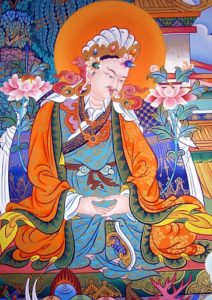
One son was reborn as Trisong Detsen, the 38th king of Tibet and an incarnation of Manjushri. Another was reborn as the king’s messenger who invited the reincarnations of the other two sons, the great Khenpo Shantarakshita and the tantric master Padmasambhava from India. Recalling his past aspirations, Padmasambhava accepted the invitation, and on his way he subdued the demons of Tibet, transforming them into faithful guardians of the Dharma.
The king, guru and khenpo together constructed Tibet’s first great monastery at Samye. They gave vows to Tibet’s first seven monks, standardized translation methods, supervised translation of most of the sutras and tantras from Sanskrit to Tibetan, and firmly established the tradition of study, contemplation and meditation, thereby radiating the Buddha Dharma in Tibet.
Guru Rinpoche miraculously walked upon the entire land of Tibet and blessed all the mountains, lakes and caves as places for accomplishment. With Yeshe Tsogyal, he concealed eighteen varieties of treasure including texts, material wealth, holy image, and made prophesies regarding the future manifestation of these treasures, including the revealer, the protector of the treasure, and the time of revelation.
The Nyingma tradition regards Yeshe Tsogyal as an emanation of Samantabhadri, the primordial female Buddha. Born as a merchant during the lifetime of a former Buddha, Yeshe Tsogyal went before him and vowed not to be reborn except for the benefit of beings. She manifested as Ganga, the Indian goddess who sprang from Lord Shiva’s topknot to flow as the Ganges, the river watering the plain of north India, and then as Saraswati, the Indian goddess of the flow of language and music. She was also a disciple of Buddha Shakyamuni. According to Nyingma tradition, in 8th century Tibet, Guru Rinpoche invoked Saraswati to manifest as a woman who would help disseminate the Mantrayana.
This remarkable hermit saint, the consort of Guru Rinpoche, is sometimes shown in Nirmanakaya form, as a woman in dressed in traditional Tibetan clothing, seated and holding curved knife and skullcup. As a meditational deity, she appears as the Queen of Great Bliss, a red figure holding a damaru drum in her right hand and a curved knife in her left.
Yeshe Tsogyal (777-837 A.D.) was born to the princely Kharchen family. At her birth spring of fresh water burst from the ground and formed a pond next to her house. This pond came to be known as ‘Lha-tso’, the divine lake. Later the spot became a famous pilgrimage site for generations of devotees.
Yeshe Tsogyal was brutally raped by her first suitor and fought over by her second. When she fled from them, she was captured and placed in the Emperor’s harem. Later the Emperor offered her as a consort to Guru Rinpoche.
Guru Rinpoche set her free, and she became his disciple at age 16. When she received empowerment her flower fell on the sacred mandala of Vajrakilaya and through practicing the sadhana she rapidly gained accomplishment. She then received all of the Guru Rinpoche’s teachings and became his spiritual heir. She travelled all over Tibet with her Precious Guru, blessing particular locations and depositing treasure-texts for the benefit of future beings.
She went into meditation retreat in 796 and did not come out until 805, after her great Guru had already left Tibet. She finally emerged as fully enlightened Buddha. Possibly in 837, but perhaps later, she transcended worldly existence, ascending to the Sacred Red Mountain, the luminous Buddhafield of her root lama Guru Rinpoche.
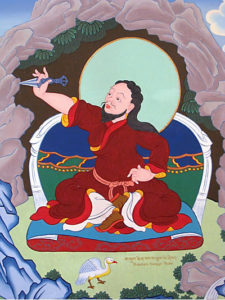
Nupchen Sangye Yeshe was one of the twenty-five disciples of Padmasambhava. Sangye Yeshe means “Buddha Wisdom.” He was the chief recipient of the Anuyoga teachings as well as the Yamantaka of Mahayoga. In addition to Guru Rinpoche, his other teachers were Traktung Nagpo and Chogyal Kyong of India, Vasudhara of Nepal, and Chetsen Kye from the country of Drusha. He visited India and Nepal seven times. When the evil king Langdarma attempted to destroy Buddhism in Tibet, Sangye Yeshe instilled fear in the king by causing an enormous scorpion, the size of nine yaks, to magically appear by a single gesture of his right hand. Through this, Langdarma lost the courage to persecute the Vajrayana sangha who dressed in white robes and kept long hair. Thus, Nubchen Sangye Yeshe is considered an important person for development of the White Sangha of lay yogis (ngagpas). Khenchen Paljea Pa Dorjee Rinpoche is considered one of his reincarnations.
Nupchen Sangye Yeshe is renowned for having preserved a number of tantric lineages through the so-called “dark period” of Tibetan history (roughly 842-978 C.E.), when state supported monastic Buddhism fell into decline. Nupchen authored many works, including the Lamp for the Eye in Contemplation (bsam gtan mig sgron), an extensive discussion of early Tibetan contemplative systems. But by far his longest work is his little read Armor Against Darkness (mun pa’i go cha), a systematic commentary on the Compendium of the Intentions Sūtra. In preparing his commentary, Nupchen studied directly under Chetsenkye and the other translators of the Compendium Sutra. In the Samten Migdrön, Nubchen Sangye Yeshe establishes a salient distinction within the Mahayana between the “Gradual Vehicle of Bodhisattvas” (Sanskrit: Bodhisattvayana) and the “Sudden Mahayana” corresponding to the Dhyana, Ch’an or Zen school.
One of the twenty-five disciples of Padmasambhava, he was the chief recipient of the Anu Yoga teachings as well as the Yamantaka of Mahayoga. In addition to Guru Rinpoche, his other teachers were Traktung Nagpo and Chogyal Kyong of India, Vasudhara of Nepal, and Chetsen Kye from the country of Drusha. He visited India and Nepal seven times. When the evil king Langdarma attempted to destroy Buddhism in Tibet, Sangye Yeshe instilled fear in the king by causing an enormous scorpion, the size of nine yaks, to magically appear by a single gesture of his right hand. Through this, Langdarma lost the courage to persecute the Vajrayana sangha who dressed in white robes and kept long hair. Khentul Paljea Pa Dorje Rinpoche is considered one of his reincarnations. Sangye Yeshe means ‘Buddha Wisdom.
Rongzom Choki Zangpo who was renowned as the supreme mahapandita of Tibet, the land of snow mountains, took birth in Narlung-rong, a subdistrict of Rulak in lower Tsang. The rite of the five awakenings of the causal phase was first performed by hi father Rongben Rincen Tshultrim, the son of Rongben Pelgi Rinpoche. Consequently, during his lifetime he was to demonstrate an enlightenment exemplifying five excellences; Dignaga’s discriminative awareness, Vasubandhu’s learning, Candragomin’s expressive style, Dharmakirti’s analytical acument, and master Aryasura’s poetic composition. It is said that Rongzompa was the immediate reincarnation of a pandita called master Smritijnanakirti, who had come to Tibet towards the end of the early propagation of the teaching. In the province of Dokam he corrected the translations of some of the tantras, and translated commentaries on the way of secret mantra.
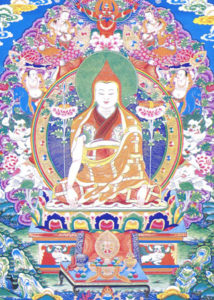
Longchen Rabjam (1308 – 1363) was the reincarnation of Princess Pemasal, the daughter of King Trisong Deutsen and a direct student of Guru Rinpoche. His birth in the Tra Valley of Southern Tibet was accompanied by miraculous events and auspicious omens. He began his Dharma training at the age of seven, when he received empowerments and teachings from his father, a tantric yogi. At twelve, he took novice monastic vows at Samye monastery.
Longchenpa studied and practiced teachings from a variety of lineages and masters. He received and mastered so many teachings, in fact, that he became known as Samye Lungmangwa, the One of Samye with Many Transmissions. Though he is associated primarily with the Nyingma lineage, he also studied many teachings of the Sarma, or New Schools, including the Kalachakratantra, Chöd, and the Path and Result teachings of the Sakya lineage. He shared a particularly close relationship with the third Karmapa, Rangjung Dorjé, with whom he studied under the Dzogchen master Rigdzin Kumaraja.
Longchenpa passed away at the age of fifty-six. He left over two hundred and fifty treatises behind, many of which are still regarded as the most comprehensive and authoritative works yet written concerning the view and practice of the Great Perfection. His most important students include the 3rd Karmapa, Rangjung Dorjé, with whom he exchanged teachings, Özer Kocha, and his son, Tülku Trakpa Özer.
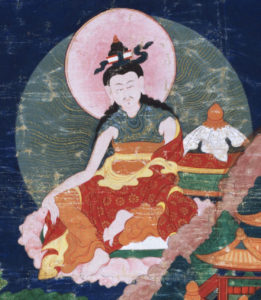
As a child Rigdzin Jigme Lingpa remembered previous incarnations, his mind was detached from worldly concerns and he was extraordinarily compassionate, intelligent and courageous. At age 6 he entered Palri Monastery, but lived the life of a poor novice with nothing to facilitate learning. His intense zeal for the Dharma, devotion to Guru Rinpoche, and rich inner life filled sustained him and he felt no need to have a master or study intellectual subjects in detail as other students were doing. He learned merely by overhearing the classes of other students or glancing at the texts. In his twenty-eighth year he started a strict retreat concentrating his meditation on the development and perfection stages. He experienced many visions of Guru Rinpoche, Yeshe Tsogyal, Manjushrimitra and others, each further awakening his inner wisdom. One evening with an unbearable devotion to Guru Rinpoche in his heart, he experienced flying through the sky to the circumambulation path of the Bodhnath stupa. In the courtyard of the stupa a dakini entrusted him with a wooden casket containing yellow scrolls and crystal beads. Encouraged by another dakini he swallowed these and instantly experienced the full awakening in his mind of all the words and meaning of the Longchen Nyingtik cycle. Three years later during a retreat at the Chimpu caves the highest realization of Dzogchen awakened in him through three visionary transmissions of the Longchen Nyingtik teachings from Longchen Rabjam. He kept them secret for seven years, until a clairvoyant disciple beseeched Jigme Lingpa to transmit them. Swiftly the teachings reached every corner of the Nyingma world and became the heart core of meditation instructions for many realized meditators to this day.
Rigzin Terdag Lingpa was the speech emanation of the great translator Vairocana. At the request of the dakinis, the body of his pristine cognition assumed the form of Heruka and Terdag Lingpa, accompanied by rainbows and various wondrous omens, was born on Monday, March 26, 1646 (tenth day, second month, fire dog year).
His mother was Yum Lhandzin Yangchen Drolma, who was herself a direct descendent of the Chögyal Dynasty of the great kings Songtsen Gampo and Trisong Deutsen. His father, Sangdak Thrinley Lhundrup, was the reincarnation of Nubchen Sangye Yeshe, one of the twenty-five disciples of Guru Padmasambhava. Sangdak Thrinley Lhundrup himself, born at Chak Jangchubling in 1611 (iron female pig year), was the son of Khedrub Don-Nga Tenzin, a learned and accomplished teacher of the Nyö clan. Sangdak Thrinley Lhundrub was a renowned scholar and teacher who studied with more than 30 highly accomplished masters of the time. He then bestowed these profound and vast teachings on his supreme spiritual son of body, speech and mind, the great treasure finder Chögyal Terdag Lingpa Rigzin Jurme Dorje.
Lochen Dharmashri received the Refuge and Bodhicitta Vows from Terdak Lingpa, who was his principle guru. At the age of twelve, Dharmashri received the empowerment of Rigdzin Thugthig (The Heart Essence of the Vidyadharas) from Terdak Lingpa, due to which his mind matured, and the pratimoksha and bodhicitta vows which he later received arose as the essence of the discipline of secret mantra.
When Dharmashri was fifteen, he received novice monastic vows from the Fifth Dalai Lama, from whom he also received full ordination when he reached the age of twenty. Fulfilling the instruction of the Dalai Lama, he later received the pure lineage of the Lower Tibetan Vinaya of the Nyingma. This was the Vinaya lineage from Kham which had survived the persecution of the buddhadharma by King Langdharma. Dharmashri became a great preserver of this tradition, widely propagating its explanation and practice. He and his elder brother, Terdak Lingpa, both sought out the great doctrine holders of the time, and received an enormous number of transmissions on an equally vast number of topics.
Jikme Gyalwe Nyugu was a great meditator, bodhisattva and adept. Born in 1765 In the Dzachuka valley, he experienced unbearable urges as a child to go to a solitary place and devote himself to meditation. As a youth he made a pilgrimage to Samye and other holy places and received instructions on Dzogchen, but his family obliged him to join his elder brother on business trips.
During these he was overcome with revulsion for the lying and cursing practiced by laypeople. When his brother died at age 18 this more than any other single event, turned his mind resolutely to Dharma, but relatives put great pressure on him to marry and take care of the family. He was forced to run away from home and traveled to Central Tibet with a like-minded friend. At Samye they met with the first Dodrupchen who advised them to see Jigme Lingpa. When they reached Tsering Jong and beheld Jigme Lingpa, Jigme Gyalwe Nyugu experienced incredible joy. They received empowerments, transmissions and detailed instructions on Dzogchen.
After several more retreats in east Tibet he returned to Tsering Jong and experienced once more the great joy of seeing the omniscient Jigme Lingpa, who invited him to stay for three years. He explained frankly that he had to go back home because of obligations. He returned to Kham and did many years retreat around Dzogchen and in Dzachuka and had many extraordinary experiences. As advised by Jigme Lingpa, he devoted the entire latter part of his life to teaching whoever came to listen, giving empowerments or meditation instructions to all who were devout and sincere. During this period, he gave Patrül Rinpoche teachings on the Ngöndro of Longchen Nyingtik 25 times as well as the teachings on Tsalung and Dzogchen.

Patrül Rinpoche (1808-1887) was born in the Dzachuka valley of Eastern Tibet. Although he is generally considered to have been the speech incarnation of the great tertön Jigmé Lingpa, Patrül Rinpoche was originally recognized as an incarnation of Palgé Tülku, a lama from Dzogchen Monastery. The first Dodrupchen Rinpoche, one of Jigmé Lingpa’s two main disciples, entrusted young Patrül with the Longchen Nyingtik lineage shortly after the recognition. He practiced, studied, and taught this lineage throughout his life.
Patrül Rinpoche studied with many different masters. His two main teachers, however, were Jigmé Lingpa’s second main disciple, Jigmé Gyalwé Nyugu, and the great tantric yogi Do Khyentsé Yeshé Dorjé, the mind incarnation of Jigmé Lingpa. Under these and other important lamas, he studied a vast array of topics, from the foundational teachings of the Hinayana up to the most profound and secret oral instructions of the Great Perfection.
At the age of twenty, Patrül Rinpoche left the residence of his predecessor and took up the life of a wandering hermit. For the rest of his days, Patrül wandered from mountain retreats to large monasteries, practicing the teachings, instructing students, and composing commentaries on important texts and practices. Though he was master of the Great Perfection teachings, he had a passion for teaching the Mahayana as well. He taught Shantideva’s Bodhicaryavatara over a hundred times. Throughout his life, Patrül Rinpoche demonstrated the impeccable life of a true siddha/scholar; he kept few possessions, had no fixed abode, and was often mistaken for a beggar due to his humble appearance.
Patrül Rinpoche’s heart disciple was Lungtok Tenpé Nyima, who lived with him for twenty-eight years. His other disciples include some of the 19th century’s most outstanding masters. Among them were Mipham Rinpoche, Khenpo Künpal, the 3rd Dodrupchen Rinpoche, the famed tertön and teacher of the 13th Dalai Lama Lerab Lingpa, and Adzom Drukpa. Patrül Rinpoche died at the age of 80.
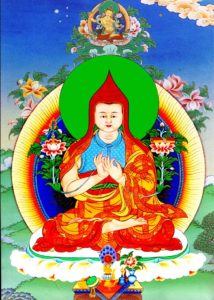
Ju Mipham (1846-1912) ranks alongside Longchen Rabjam and Tsongkhapa as one of Tibet’s most prolific and influential masters. His presentation of the Nyingma School’s unique approach to the view and practice of Buddhism, and in particular the relationship between Madhyamaka and the Great Perfection, has had an enormous impact on the past few generations of Tibetan Buddhist scholars and practitioners.
Namdrolling Monastic College, currently the largest functioning Nyingma educational institution, includes twenty of his texts in its curriculum. By comparison, only five texts by Longchenpa are included and only one by Rongzom Pandita.
Mipham’s primary teachers were Patrül Rinpoche and Jamyang Khyentsé Wangpo, both incarnations of the tertön Jigmé Lingpa. Khyentsé Rinpoche requested Mipham to preserve the Nyingma teachings through teaching, debate, and composition—a task in which he admirably succeeded. About his remarkable student, Khyentsé remarked, “In this time, there is no one else on earth more learned than lama Mipham.”
He excelled not only in study and teaching, however, but in practice as well. The numerous retreats he completed were always accompanied by miraculous signs of accomplishment.
Mipham Rinpoche’s collected writings comprise twenty-seven volumes and cover a vast array of topics. Among his most influential writings are The Speech of Delight—a commentary on Shantarakshita’s Ornament of the Middle Way, Gateway to Knowledge, which provides an overview of the Buddha’s teachings, and Beacon of Certainty—an elucidation of the view of the Great Perfection and its relationship to the Middle Way teachings.

Nyoshul Lungtok was the greatest realized disciple of Patrul Rinpoche. Living with his teacher for about twenty-eight years without separation, he received the transmissions of various teachings, especially the Nyingtik teachings of Longchen Rabjam and Jigme Lingpa. One day at the Ari Forest Patrül asked Lungtok if he remembered his mother. When Lungtok said, “Not much, sir”, Patrül Rinpoche sent him into the forest to meditate on ‘recognizing motherhood and ‘remembrance of mothers kindness.’ Lungtok meditated as Patrül Rinpoche had instructed and the bodhicitta of loving-kindness and compassion developed naturally in him.
One clear evening in a hermitage above the Dzogchen monastery Patrul Rinpoche called Lungtok and asked “Did you say that you do not know the true nature of mind?”
Lungtok nodded.
“It’s very simple”, he said, and lying down on the ground, beckoned to Lungtok to join him. Then Patrul Rinpoche asked: “Do you see the stars in the sky?”
“Yes”
“Do you hear the dogs barking in Dzogchen monastery?”
“Yes”
“Do you hear what I am saying to you?”
“Yes”
“Well, that is the meditation.”
At this moment, everything fell into place. Instantaneously Lungtok gained liberation from conceptual fetters and realized the primordial wisdom, the Buddha Mind.
Throughout his life he shared the teachings of Patrül Rinpoche with all who came to him, and after the age of fifty, as instructed by his teacher, he gave Dzogchen teachings. Like Patrül Rinpoche he rarely gave transmissions of empowerment. When he died at the age of seventy-two rainbow lights arched overhead and many other signs appeared of the passing of a realized master.
Ngagi Wangpo was a most unusual child. Even as a baby he displayed miraculous powers and had visions of deities. One day his mother took him to Nyoshul Lungtok to receive blessings. Although the master was in retreat he instructed his attendant to bring any visitors who asked for blessings on that particular day. When mother and son arrived he bestowed the name of Ngawang Palzang upon the boy, gave him a cup of consecrated raisins and a red protection cord for long life.
At age 10, Ngawang Palzang became the disciple of Nyoshul Lungtok and began the preliminary Ngöndro practices. When he was about 13 years old, Nyoshul Lungtok gave him a thangka painting of Longchenpa, and a hair of Jigme Lingpa and instructed him to pray to Longchenpa. One day during his mandala practice Ngawang Palzang had a vision of Longchenpa holding a crystal in the shape of a heart and Longchenpa introduced him to the nature of mind.
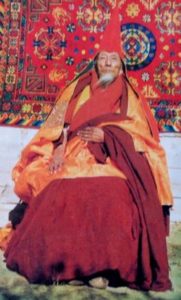
Rigdzin Wangshu (Tulku Arik Rinpoche) followed masters holding several great spiritual lineages, including the Sakyapa, Longsel and Nyingtik and from an early age he laid special stress on practice. He never accumulated money or goods, disliked talking and forgot language for a time after a 6 year vow of silence. On a pilgrimage to Samye Monastery he lived by begging alms and took a walnut shell as his water cup.
He lived in seclusion for a many years in Trom, Eastern Tibet, and had few disciples, but nearly all of them gained spiritual attainments. His root teacher, Ngagi Wangpo, prophesied that he would live for 80 years; and Terton Sera Yantual prophesied that he would lead more than a hundred thousand disciples to attain the rainbow body and enter Guru Rinpoche’s pure light Buddhafield. When Tulku Arig Rinpoche passed away in 1988 rainbows manifested and five-colored relics appeared among his physical remains.
Khenchen Tupten Chopel of Changma was a student of Khenchen Yonten Gyatso. His birthplace was a nomadic community in the Batur region of the Dalung river valley in the northern reaches. He was considered to be someone holy sin matters such as faith, renunciation, a lack of interest in worldly matters, and compassion. At the age of eleven, he entered the monastic community of Puntsok Norling and, beginning with reading and writing, trained in all the usual fields of knowledge.
He was ordained as a novice by Khenchen Yonten Gyatso. At twenty-four Tupten Chopel requested additional vows and became a fully ordained monk. Tupten Chopel studied myriad source texts and pith instructions of the Early Translation school. In particular, from Khenchen Yonten Gyatso, the extraordinary master of his buddha family, Tupten Chopel received the earlier and later cycles of the secret Nyingtik teachings of the Dzogchen approach, as well as teachings on the most majestic tantra, and other cycles, receiving these as experiential transmissions based on the oral instructions of the lord of the dharma Paltrul Rinpoche. He put these teachings into practice and experienced the enlightened intent that is the ultimate lineage. Serving thus as a glorious protector of the teachings and of beings, Tupten Chopel lived for seventy-one years. Of his students, the foremost were Khenchen Jigme Puntsok, Khentrul Jigme Namgayl, Kyabje Dilgo Khyentse Rinpoche and Khenchen Pedma Tsewang of Arigzha.
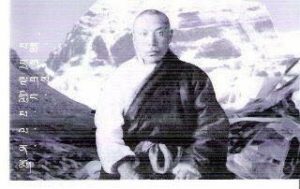 Rigdzin Padma Dragngag Lingpa
Rigdzin Padma Dragngag Lingpa
Rigdzin Padma Dragngag Lingpa [Read Biography]
Botrul Do-ngak Tenpai Nyima (1900 – 1959) was born in Dakpo, in the eastern part of central Tibet. When he was very young, his spiritual predisposition awakened and he entered the path of dharma. At a certain point, he joined an eastern Tibetan merchant on a pilgrimage and journeyed to eastern Tibet in search of teachings. Because he was still so young and his homeland was far away, Do-ngak Tenpai Nyima had no provisions for supporting himself while receiving teachings and therefore endured many hardships, including a lack of adequate clothing, and adopted a way of life reminiscent of the lord Milarepa’s.

He finally reached Dzogchen Monastery in eastern Tibet and studied with all of the gurus, tulkus, khenpos, and teachers residing there, investigating the thirteen great source texts and teachings from the sutras, tantras, and other fields of knowledge. He joined the ranks of the learned. From Dzogchen Tupten Chokyi Dorje, he received many empowerments and oral transmissions for the practice of tantra. Dzogchen Rinpoche took responsibility for Botrul Do-ngak Tenpai Nyima and accorded him many honors. For example, he conferred the title of tulku on him, seated him during large gatherings on a throne that stood in the center at the back of the hall, and assigned several monks as his attendants when he traveled. Everyone honored him as Bopa Tulku.
Botrul Do-ngak Tenpai Nyima attracted many students from all directions and upheld and fostered Mipham Rinpoche’s teaching methods. Among his students were Khen Chochap, Pema Tsewang Lhundrup, Khen Tupten of Mepa, Khen Tupten of Rahor, Khen Dazer, and many other learned masters. He wrote numerous extensive and more concise works, including The Delination of the Tenets of View, An Overview of the Perfection of Sublime Knowledge, and A Word-by-Word Commentary on the Perfection of Sublime Knowing.
After taking birth in Dza Chukha in the eastern area of Dokham, Khenchen Pema Tsewang Lhundrup was from early childhood endowed with an extraordinary intelligence and a compassionate character. Many accomplished masters foretold that he was an emanation of Vajrapani, the Lord of Secrets, who is the compiler of the teachings of all the victorious ones, and of great beings such as the Tibetan great Lotsawa Dharma Shri.
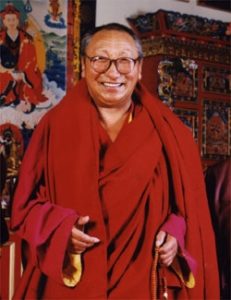
When eleven years of age, he received the ordination to be a novice. From then on and up to the age of 28, he followed numerous learned and accomplished spiritual masters including Adzom Gyalsey Gyurmey Dorje, Tubga Yishin Norbu, Botrul Tamchey Khyenpa, Jamgon Shechen Kongtrul, Paltrul Namkha Jigmey, Pukung Khenchen Chodor, and many others. From these masters he received the complete training in Sutra, Mantra and the authoritative fields of knowledge, and thereby earned the title “mahapandita of the five-fold fields of knowledge.”
At the age of 28, he received the full monk ordination from Dzogchen Khenchen Tubten Nyendrak and has since then correctly observed the three level of precepts – Pratimoksha, Bodhisattva, and Mantrayana – with neither conflict nor transgression. Due to his peaceful nature and his gift for never getting angry, he has become an example for Buddhists all over the world.
From 29 to 51, he remained in loose retreat during which he chanted the Manjushri Nama Sangirti Tantra in six hundred verses several hundred thousand times. In this way he has earnestly practiced, like the steady flow of a river, the profound and secret levels of meditation and sadhana, and hereby realized the self-existing wakefulness of the Great Perfection in which insight and compassion are indivisible.
From the age of 52, he functioned as the khenpo at Dzogchen Shri Singha, the great Buddhist Institute for Higher Learning. There he taught for four years several hundred students in the ten fields of knowledge. He has traveled widely throughout the world, and it is through his kindness of constantly teaching the sublime Dharma of both Sutra and Tantra, that he has spread an immense benefit that extends to many hundred thousand people.
In short, he is an accomplished great Dharma Master, a confluence of erudition, purity and noble-mindedness. At present, his residence is at the newly built center for teaching and practice for monks and nuns near Arig in eastern Tibet where he lives at a mountain hermitage while teaching the Dharma of Sutra, Mantra and the fields of knowledge.
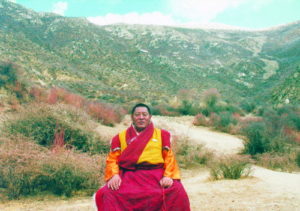
Khenchen Jigmed Phuntsok Rinpoche (1937 – 2004) was born in 1937 in eastern Tibet. He was a reincarnation of the great master Terton Lerab Lingpa, and discovered terma treasures in this lifetime as well. Rinpoche was the foremost teacher in residence in modern Tibet. A brilliant scholar and eloquent speaker, he regularly addressed gatherings of monks, nuns and lay people numbering in the thousands. He was the founder of the great university center of Larung Gar that attracted over 15,000 students drawn there by his greatness.
In 1993, Rinpoche was able to visit H.H. the Dalai Lama in India and bestow transmissions to His Holiness. H.H. Khenpo Jigme Puntsok Rinpoche passed away at the age of 72 years on the evening of January 6, 2004, in a military hospital in Chengdu, China. His recent passing is a great loss to Buddhism in Tibet.
Khentrul Rinpoche Jigmed Namgyal (1921-1991) was one of the greatest scholars in Tibetology, as well as an accomplished Dzogchen Master and Mahasiddha of the rainbow body. Rinpoche was born in the Fire Tiger year in Kham area, nearby a sacred terma place of Guru Rinpoche, Zhalhong Lhari Mountain (today’s Dege District of Sichuan Province). Rinpoche was recognized by the 5th Dzogchen Rinpoche, Thubten Chokyi Dorje, as the unmistaken reincarnation of the previous Terton Pawo Dorje (the manifestation of one of the 25 disciples of Guru Rinpoche, Verotsana – the guru of the Great Jamyang Khyentse Chokyi Lodro – and other masters). In the Earth Dragon year of Tibetan Calendar, Drukpa Rinpoche was enthroned as a high ranked master of the Dzogchen Monastery.
Rinpoche was renowned for his impartial loving kindness and compassion. Without caring much about his own interests and benefits, he always dedicated himself wholeheartedly and selflessly for the benefit of all. He upheld and maintained pure precepts and virtuous conducts, which made him a great and exalted example of living Bodhisattva, who was highly praised and admired by all. Rinpoche was employed as the professor of Tibetan language in the Higher Buddhist Institute of China and other important positions in social and cultural organizations.

Khenchen Parchhimbha Dorjee Rinpoche – Khenchen Lama Rinpoche – Since very early childhood he displayed unusual compassion and inclination towards meditation. At the age of three, the head of Nyingma lineage – His Holiness Sera Yangtul Rinpoche – recognized Khenchen Rinpoche as a reincarnation of Padma Dagnag Lingpa, a high Rinpoche of Nyingma lineage. Padma Dagnag Lingpa was a reincarnation of Nupchen Sangye Yeshe, one of the five closest disciples of Padmasambhava and the founder of the yogi lineage of Tibetan Buddhism. H.H. Sera Yangtrul Rinpoche also prophesized, that Khenchen Rinpoche would especially benefit students in Europe and the USA in this lifetime.Despite the pressures to take over abbot responsibilities at four monasteries at an early age, Khenchen Lama Rinpoche was encouraged by his mother to undergo rigorous study and practice. For 25 years he studied and practiced primarily Buddhist philosophy and meditation, but also logic, medicine, astrology, languages, grammar, lexicography, dance, and drama. During this time his root teacher His Holiness Jigmed Phuntsok Rinpoche provided him with teachings and instructions over a period of ten years at Larung Buddhist University. While studying, Rinpoche spent two to three months each year in silent solitary retreat summing up to about four years of retreat in total. After receiving his khenpo and khenchen titles, Khenchen Lama taught debate, astrology, sutra and tantra at many different monasteries and centers in Tibet, Nepal, India, Malaysia, Singapore, China and the United States. The main focus of his teachings is on Dzogchen and the Six Bardos, especially dream yoga. Besides teaching, his main efforts have concentrated on building and sustaining an orphanage in Tibet that currently provides accommodation, food, clothing and education to 150 children (Awam Foundation). He would also like to build a retreat center for yogis in Tibet in the future. He authored three books on sutra and tantra, and wrote a book of songs